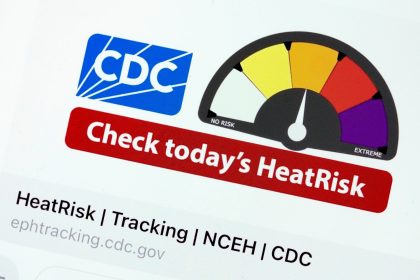CDC Issues COVID-19 Warnings, New Recommendations

WASHINGTON — The next few months of the COVID-19 pandemic will likely be the most difficult yet, warned Centers for Disease Control and Prevention Director Robert Redfield, who said the agency would cooperate with the incoming Biden administration.
Redfield’s remarks at a U.S. Chamber of Commerce event Wednesday came as the CDC also announced some changes to guidelines for people after exposure to COVID-19.
His comments acknowledging that he would be leaving the CDC next year when President-elect Joe Biden takes office deviated from many other Trump administration political appointees.
“My time as CDC director is coming to an end in January. This nation was severely underprepared for this pandemic and I think we have to call it the way it is,” said Redfield, emphasizing that consistency in messaging and thoughtful interventions based on data will be key to mitigation.
“I know I’m going to do a lot of reflection when I get out in January because I do think that’s the key that we owe the next group is what did we learn, what did we learn that works, what did we learn that didn’t work?” he said.
The nation’s top public health official’s warning about an exponential rise in deaths over the next three months was unusually stark.
“December, January and February are going to be rough times. I actually think they’re going to be the most difficult time in the public health history of this nation,” said Redfield. “The mortality concerns are real, and I do think, unfortunately, before we see February, we could be close to 450,000 Americans that died from this virus.”
But Redfield also noted that this number could change if the public becomes serious about following mitigation strategies.
“When you ask me the big question of how many people are going to die between now and Feb. 1, I’m going to really come back and say it’s really up to us,” he said.
Redfield also said the agency will release guidance this week to advise institutions like schools and companies to use testing for COVID-19 as routine screenings. The administration has sent tens of millions of rapid tests to states, many of which have been used to help reopen schools. But confusion over how to best interpret the accuracy of the results has frustrated many, particularly nursing home providers.
He also doubled down on the importance of in-person learning for children.
“Elementary schools are not a source of transmission,” said Redfield. “I think when the careful studies are done, you’re going to see that kids that are in virtual learning probably have a higher transmission rate than those that are in face-to-face learning.”
Redfield also said he anticipates that being vaccinated against COVID-19 will become a requirement for health care workers, and likely for long-term care facility workers or airline industry employees.
“The pandemic in the world is not going to be controlled for multiple years,” he said. “It will be a decision each industry will make but I do think there are certain industries that it will be important to protect their workforce and other industries where it might be important to protect their customers.”
He estimated that the United States will have approved three or four vaccines before February and that two of those vaccines would be approved by the first of January.
Redfield said he expects that limiting crowd size and gatherings will remain the norm until the fall of 2021. CDC officials affirmed Wednesday that the agency is maintaining its warning against travel and combining households for Christmas and other holidays.
“Cases are rising and the safest thing to do is to postpone holiday travel and stay home,” CDC Travelers’ Health Bureau Chief Cindy Friedman told reporters. “Travel volume was high over Thanksgiving and even if only a small percentage of those travelers were asymptomatically infected, this can translate into hundreds of thousands of additional infections moving from one community to another.”
For anyone who might decide to travel, the agency recommends getting tested one to three days before the trip, and again three to five days after returning. Individuals should avoid nonessential contact with other people for seven days or more after their return, even if they receive a negative test.
“I just want to also point out that testing does not eliminate all risk,” Friedman said. “But when it’s combined with reducing nonessential activities, symptom screening and other precautions such as wearing masks and social distancing, it can make travel safer by reducing the spread of COVID-19.”
The CDC on Wednesday also unveiled two alternatives to the standard 14-day quarantine for individuals potentially exposed to COVID-19.
The new guidelines were first reported last week, and subsequently confirmed by administration officials. While the agency continues to say that a full 14-day quarantine is the safest course of action, new recommendations allow individuals who have not developed symptoms to leave isolation after 10 days, or seven days if they also receive a negative test.
Abandoning quarantine before 14 days carries a “small, residual risk,” COVID-19 response Chief Medical Officer John Brooks told reporters. Individuals leaving quarantine after 10 days have a 1% average risk of spreading the virus, while those leaving after seven days of receiving a negative test have a 5% risk.
Eligible tests include both rapid point-of-care tests and traditional lab tests, as long as the sample is collected within 48 hours prior to the end of isolation. The risk was the same under both testing methods, Brooks said.
Health experts like Brown University School of Public Health Dean Ashish Jha and former Food and Drug Administration Commissioner Scott Gottlieb lauded the move in recent days. The goal is to encourage stronger adherence to quarantine recommendations while still blocking the majority of community spread.
“We are hearing anecdotally from our partners in public health that many people are discontinuing quarantine ahead of time, because there’s pressure to go back to work, to get people back into school,” Brooks said. “And it imposes both a mental and possibly also a physical burden on individuals. One of our hopes is that we can increase adherence to quarantine if we reduce the amount of time they have to spend.”
___
(c)2020 CQ-Roll Call, Inc., All Rights Reserved
Distributed by Tribune Content Agency, LLC























